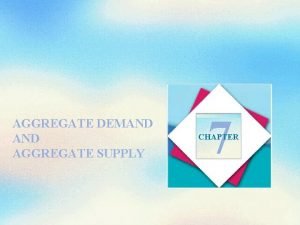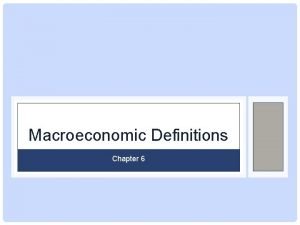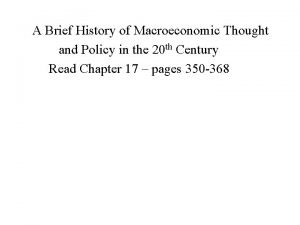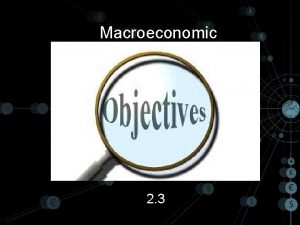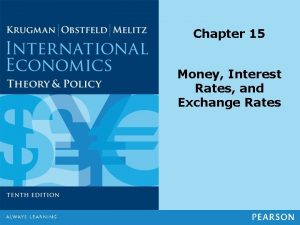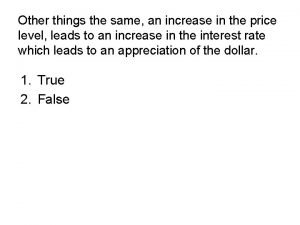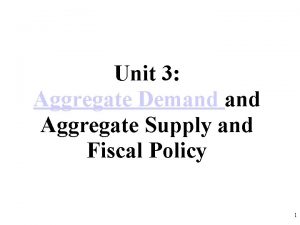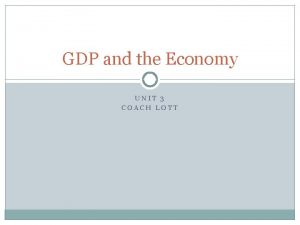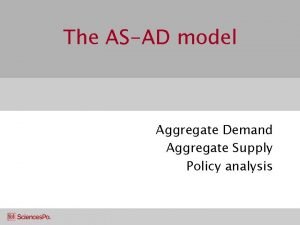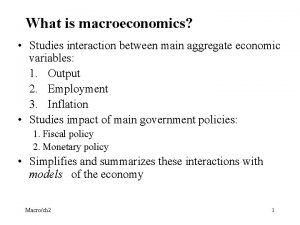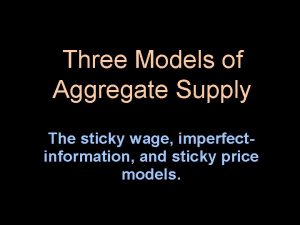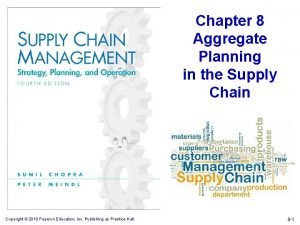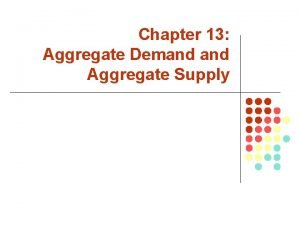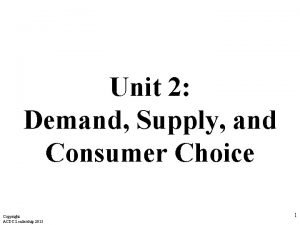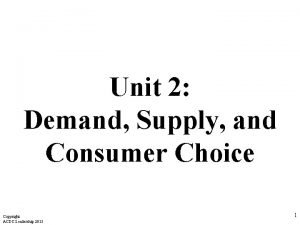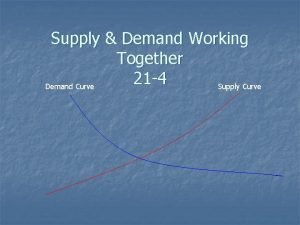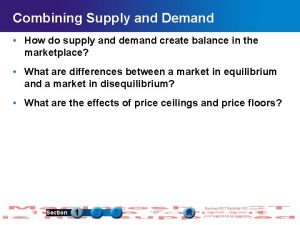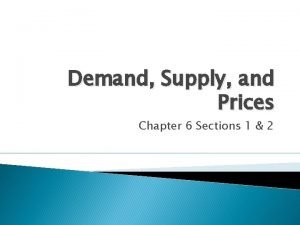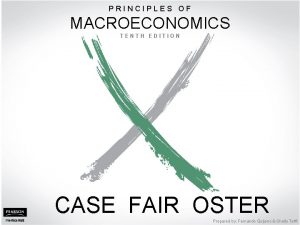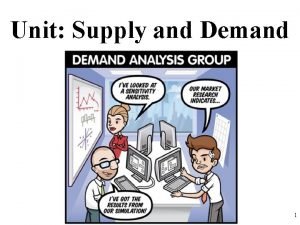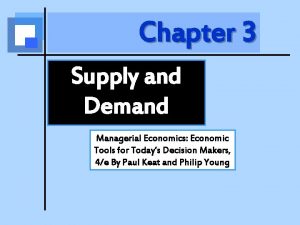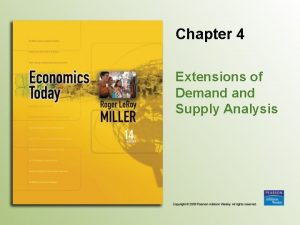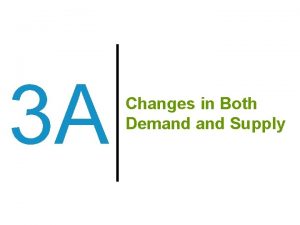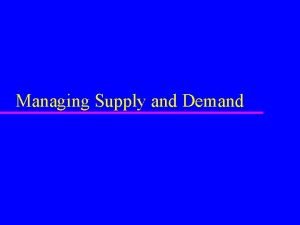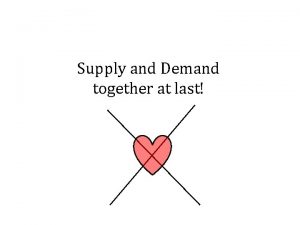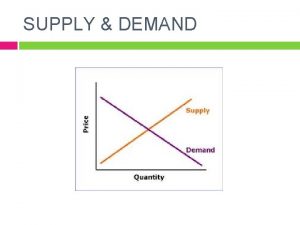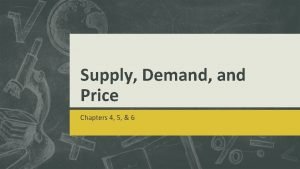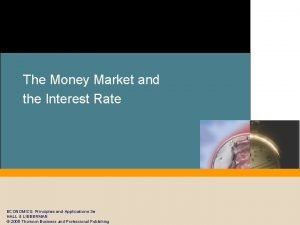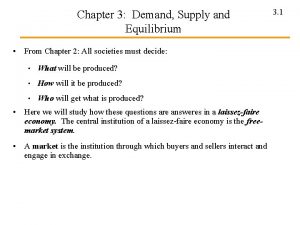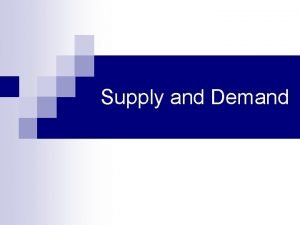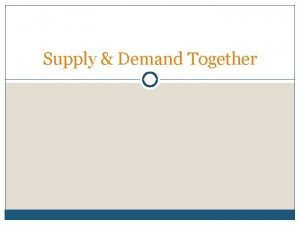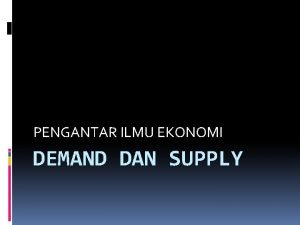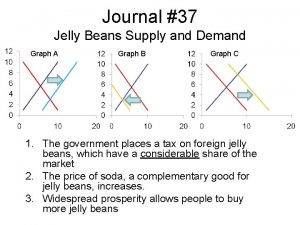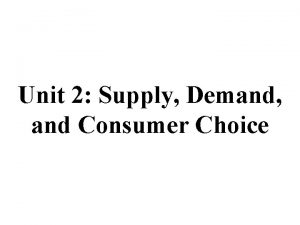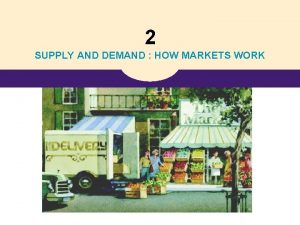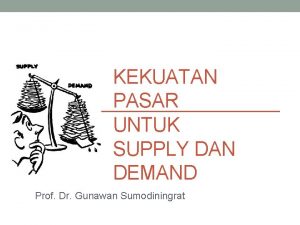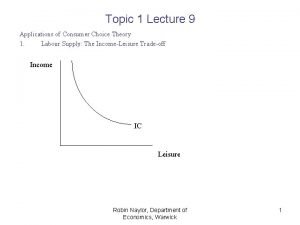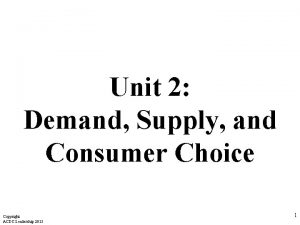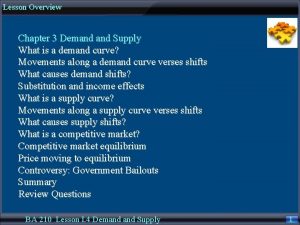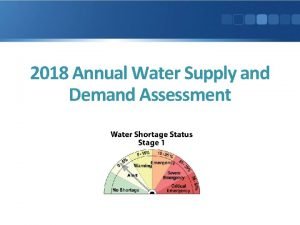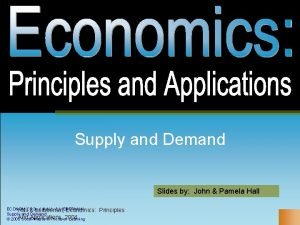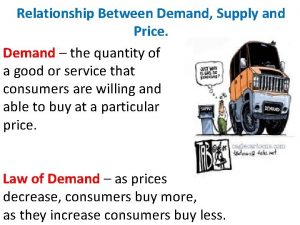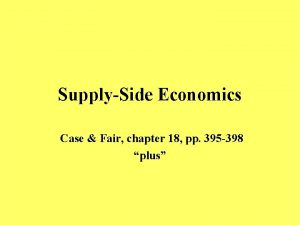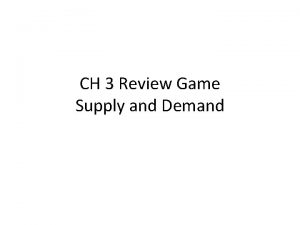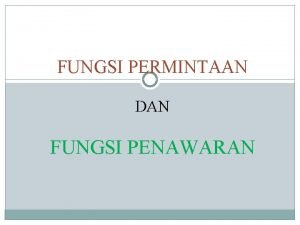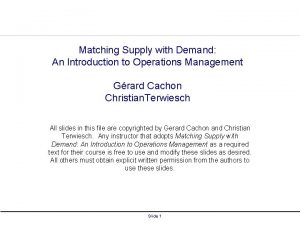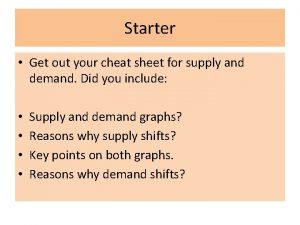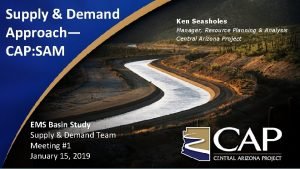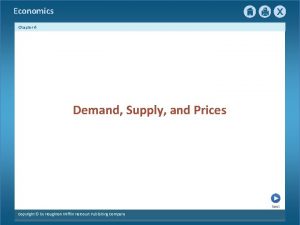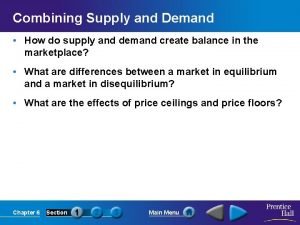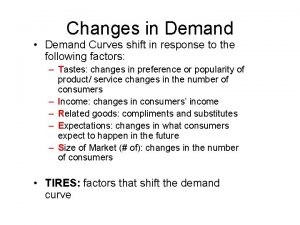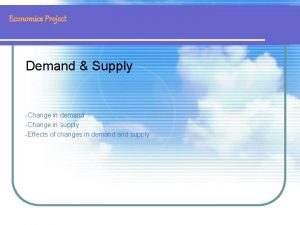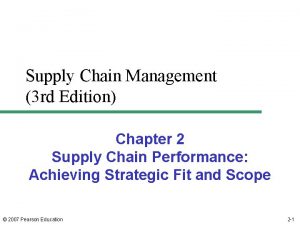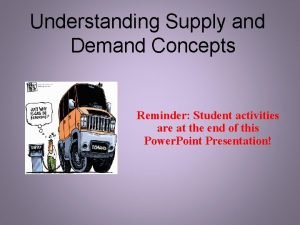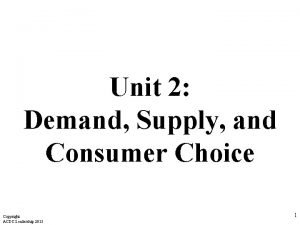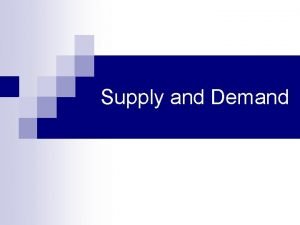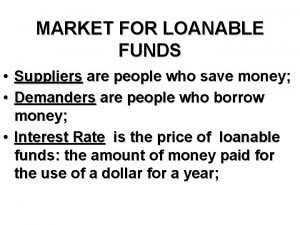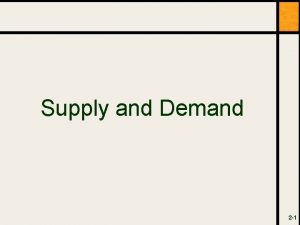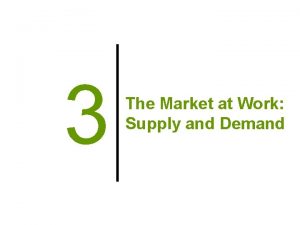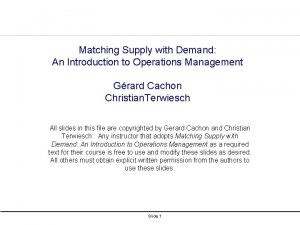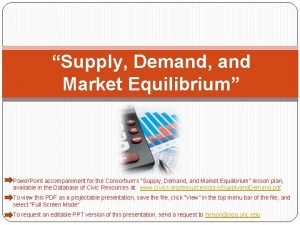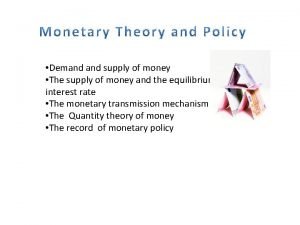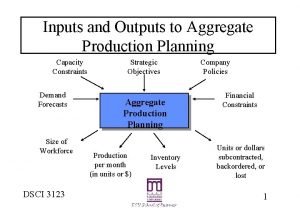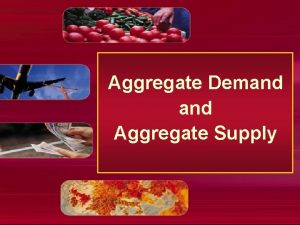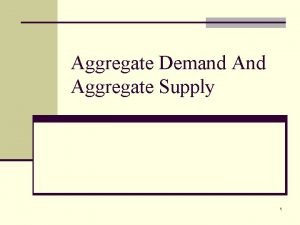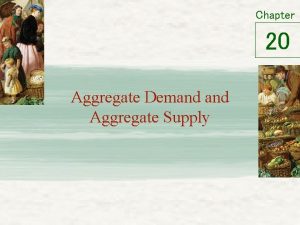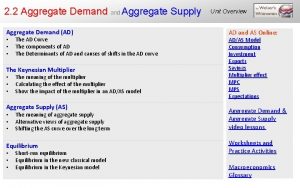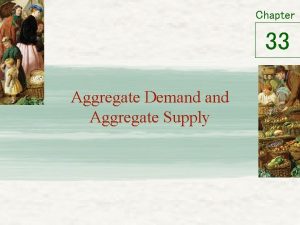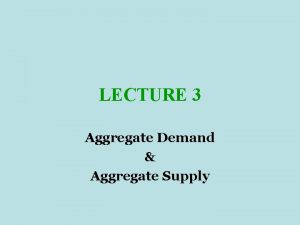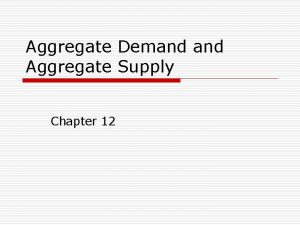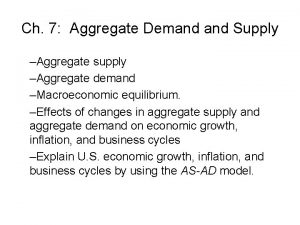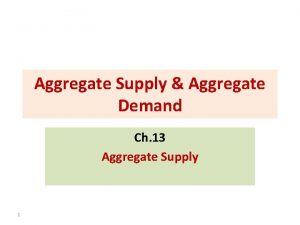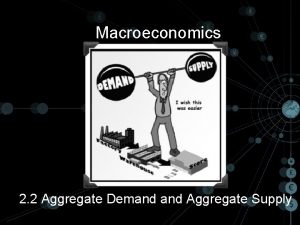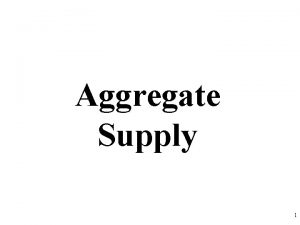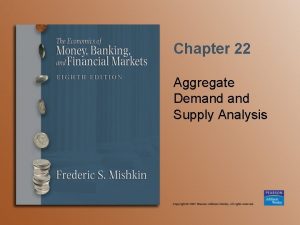2 2 AGGREGATE Demand AGGREGATE Supply Macroeconomic Goals








































































































































- Slides: 136

2. 2 AGGREGATE Demand AGGREGATE Supply


Macroeconomic Goals • Lots of debate • Not a lot of knowledge among all decision makers. (homework) • General agreement on 5 goals

5 main goals • Full employment – Controversial as to what this exactly is • Price stability – Control inflation • Economic Development – - increase HDI • Economic Growth – Increase in r. GDP • External Equilibrium

5 main goals • Full employment – Controversial as to what this exactly is • Price stability – Control inflation • Economic Development – - increase HDI • Economic Growth – Increase in RGDP • External Equilibrium

Conflicts among goals • • Full employment vs price stability Growth vs development External vs internal There is lots of debate about which lever to pull first • Let’s start with Economic Growth – Inflation, employment will be later in Sec 2 – External equilibrium is Sec 3 – Economic Development is Sec 4

Economic Growth • 2 sides to the economy

2 sector circular flow

Economic Growth • 2 sides to the economy – Consumption and Production • Consumption is also known as “demand” • Aggregate

Aggregate Demand















WAS Largest Mall in Europe

Remember? • • • Formula for GDP C + G + I + (X-M) Same formula for Aggregate Demand r= Adjusted for inflation

Consumption (C) • Services • Goods – Durable vs non -durable • N. B. Durable goods affected by credit availability


• Gw ill co me l ater …. .

Investment (I) • Replacement investment - maintain • Induced investment - expand

Trade (x-m) • Looking at net figure • AKA Balance of Trade

Simple rule • • When price goes up Demand falls So…. When general price level is higher…. • r. GDP is lower • (AKA National Income)

Aggregate Demand General Price Level A PL AD Real National Income Y

Aggregate Demand • What about general price level? – Consumer price index (CPI) – Mostly theoretical – And sometimes hypothetical

CHANGE in AD • IF PL (general price level) changes then AD changes inversely • It is downward sloping curve

Aggregate Demand General Price Level A B AD Real National Income

2 causes of change in AD • Macroeconomic Income Effect – Prices go up or down (be careful) • Macroeconomic Substitution Effect – A cheaper alternative is found – Since it is macro: • Substitution has to come from outside the economy – Leakages – Imports, savings etc • Very simple AND only along the curve • Vocabulary - RISE and FALL …. inverse • NOT what we will spend most of our time on.

SHIFT in AD • Looking at the total economy: • Income and/or wealth changes C • Income = wages, salaries, tips, etc • Also includes availability of credit (ie loans) – So if interest rates go up – Consumer income goes down – And also savings could increase (leakage) • Wealth = assets – Physical and monetary – Change in house/stock prices affects this • Business investments changing • Also affected by interest rates (credit availability) I




4 sector flow chart

Shift in AD • Government policies changing G • Politically driven • Happen in two areas • Fiscal policy – Direct spending by government » Military, social welfare, increase/reduce taxes • Monetary policy – Control of money supply » Central Banks (ie Federal Reserve, ECB, Bank al Maghreb ) empowered to make money (loans) easy to get (loose) » Or hard to get (tight)

Fiscal Policy • Expansionary • Contractionary

Monetary Policy • We will deal with this much more in “inflation” but for now…. . • Banks are regulated by a Central Bank (Federal Reserve, ECB, Bank al Maghreb) • Central Bank loans money - Base Rate or Discount Rate • Banks then loan to consumers/business/each other. • Big businesses get Prime Rate • Central Bank can also affect “required reserve”

US Central Bank

Comparison

Monetary Policy • Expansionary (Loose) • Contractionary (Tight)

Impacts (more in Sec 2. 4)

Balance of Trade • • If you export more… increase r. GDP due to increase in I More jobs= more spending (affects C) Also, you are selling more overseas so affects____ • If you import more…. . Tertiary vs Primary/Secondary ? ? ? • Why demand for imports? (increased C)

Aggregate Demand General Price Level A B AD 2 AD AD 3 Real National Income

Demand Side Shock • Temporary event • AD increases (shifts right) or decreases (shifts left) • Due to political, natural events • After shock, AD returns to normal

10 Causes of SHIFT in AD 1. ∆ in wealth/income 2. ∆ in consumer confidence (expectations) 3. ∆ in interest rates 4. ∆ in technology 5. ∆ in business confidence 6. ∆ in fiscal policy 7. ∆ in monetary policy 8. ∆ in exports/imports 9. ∆ in exchange rates 10. Demand side shock • Vocabulary: increase and decrease.

III. Aggregate Supply • Same idea as AD - total amount of goods/services available • But reverse holds true: • When PL is up, AS (aka Y) is up • Parallel relationship • Upward sloping curve

Aggregate Supply General Price Level AS A P 1 Y 1 Real National Income

III. Aggregate Supply • Same idea as AD - total amount of goods/services available – But reverse holds true: • When PL is up, AS is up • Parrallel relationship • Upward sloping curve • Simple rule - when demand meets supply the economy is in harmony (equilibrium)

Aggregate Demand Supply General Price Level AS A P 1 AD Y 1 Real National Income In other words, there are no shortages or excess (surplus) at point A. Equilibrium

Why is this important? • Key to understanding: – Unemployment – Inflation – And government policy towards economy • • Goal: Moving the equilibrium point…AKA r. GDP = that spot of intersection AKA:

r. GDP/Y/National Income/AD&AS Equilibrium General Price Level AS A P 1 AD Y 1 Real National Income

III. Aggregate Supply • Same as demand - total amount of goods/services available. • Simple rule - when demand meets supply the economy is in harmony (equilibrium) • UNFORTUNATELY there are two types of aggregate supply (AS) – Short Run (SRAS) – Long Run (LRAS)

Short Run AS • Producers can change labor input to increase/decrease production • BUT don’t have to build new factories etc • Ex: Holiday shopping season, tourism season. increase/decrease • They are not necessarily responding to current prices. • Labour costs ∆

Aggregate Supply: short run • In the short run price is fixed so the aggregate supply curve is horizontal. P . SRAS P* Y Y

But what if price isn’t fixed? General Price Level AS A P 1 Y 1 Real National Income

An example (soon to be complicated) • • • A gas station Long weekend approaches Lots of people are going to take driving vacations Owner hires a few more attendants. (supply rises) When weekend ends, he fires extra help NOW - imagine this on an economy wide scale

Long Run AS • Remember the PPF? • Since producers make long term decisions (hopefully) then they already have the capacity to handle short term fluctuations • But…. . what if they change their outlook on the future?

2 views of LRAS General Price Level SRAS National Income

Shifts in Short Run Aggregate Supply LRAS General Price Level P 2 P 1 SRAS 3 SRAS 1 AD SRAS 2 Y 1 Y 3 Yfc Remember Ceteris Paribus National Income

What makes supply? • Land – materials • Labor – Skills • Capital – Technology – Machines • Entrepreneurship/risk • FACTORS OF PRODUCTION

So we have a conflict • Based on the issue of “full employment” and “capacity” • When is economy able to fully provide enough supply to meet demand? • Is it now? Or do we need to manipulate it?

Scenerio: 2 sides • Team 1 • Brainstorm all the possible things we currently make with Gold or Gold parts. • Team 2 • Brainstorm all the possible things that you could make with Gold THAT DO NOT ALREADY EXIST.

Keynesian view LRAS General Price Level SRAS National Income

Monetarist(neo classical) View General Price Level LRAS SRAS National Income

“Capacity” • • • Size of workforce Output per worker Available technology Available raw materials Capital stock

So… • Is economy using all materials/labor/capital available? • Are we on the PPF curve or at “I” ? • And what is the determination of full employment? • Ceteris Paribus » QUIZ NEXT CLASS » Homework AS worksheet, pg 1 & 2

Two main schools of thought • Keynesian • Monetarist (neo -classical)

Keynesian • John Maynard Keynes (1883 -1946) • British • Lots of assumptions to challenge. • For now: full employment is never reached w/o government intervention. • LRAS has three phases AND is dependent on PL

Keynesian view LRAS General Price Level 1 National Income Phase 1 - spare capacity exists, producers can increase w/o incurring more costs, or increasing prices

Keynesian view LRAS General Price Level 2 National Income Phase 2 - scarcity bids up general price level as producers pass on costs to consumers. Higher prices increase production

Keynesian view LRAS General Price Level 3 Full Employment Level of output National Income Phase 3 - it is impossible to increase production b/c economy is at full capacity. NOW something must be done to change capacity. Prices go up, output stays the same.

Keynesian view General Price Level LRAS 1 LRAS 2 National Income Shift the curve - how do we get supply to increase at same prices?

The Monetarists (neo-classicals) • Friedrich Hayek (Austrian School) • Milton Friedman (Chicago School)

Monetarist (neo-classical) view • There is no build up to capacity • Economy already exists at capacity • Potential output is dependent on QUALITY and QUANTITY of factors of production • Suppliers need incentives to shift supply curve. • If you give consumers more money, it will only raise prices.

Monetarist(neo classical) View LRAS 1 LRAS 2 General Price Level SRAS 1 SRAS 2 National Income

In simple English • Keynesian view is that suppliers will respond if more money is injected at consumer level and/or prices rise. • Monetarist view is that suppliers will only respond to incentives (market or forced)


Stickiness • Wage – Contracts – resistance • Price – Information speed – Other factors

Fantasy land • For Monetarist to work: • No unions • No minimum wage laws • No price guarantees • For Keynesian to work • Huge government debts • Huge tax increases on wealthy • Huge risk of inflation

Aggregate Demand Supply LRAS General Price Level Pe SRAS AD Ye Yfc National Income

Inflationary and Deflationary gaps • Anytime the AD curve is on the AS curve BELOW full employment level of output • We have a Deflationary Gap (aka output gap)

Deflationary Gap LRAS General Price Level Pe SRAS AD Ye Think “I” on PPF Yfc National Income

Inflationary and Deflationary gaps • Anytime the AD curve is on the AS curve BELOW full employment level of output • We have a Deflationary Gap (aka output gap) • Conversely, Inflationary Gap is when

Inflationary Gap LRAS General Price Level AD SRAS Yfc More on this Later………. National Income

Causes of Change in AS • There is only 1 thing that will cause a change (or movement along) the AS curve

Movement along curve LRAS General Price Level B A SRAS National Income

Keynesian view LRAS General Price Level B A National Income

Monetarist(neo classical) View LRAS General Price Level SRAS B A National Income Note: A-B never happens unless AD shifts

Change in AS • If it moves UP the curve then… • If it moves DOWN the curve • Remember Vocab here is Rise/Fall

SHIFTS • 3 Causes of SRAS Shift – TEMPORARY • ∆ in wage rates • ∆ costs of raw materials • ∆ price of imports (can include F/X rate) • 4 Causes of LRAS Shift • ∆ in quality of Fof. P • ∆ in quantity of Fof. P • Market Oriented Supply Side Policies • Interventionist Supply Side Policies

Shift in SRAS General Price Level SRAS 1 SRAS 2 A P 1 B P 2 AD Y 1 Y 2 Real National Income

An Increase (shift) in Long Run Aggregate Supply LRAS 1 LRAS 2 YFC 1 YFC 2 General Price Level SRAS 1 SRAS 2 Real National Income

Aggregate Demand Supply General Price Level LRAS P 2 P 1 SRAS 2 SRAS 1 AD Y 2 Y 1 Yfc National Income

Shifts in Short Run Aggregate Supply LRAS General Price Level P 2 P 1 SRAS 3 SRAS 1 AD SRAS 2 Y 3 Y 1 Y 2 Yfc Remember Ceteris Paribus National Income

Out of the Abstract • 2 lines • AS & AD • Red construction paper is the Equilibrium Price • For our purposes, two people will hold it.

Back to Basics • What does r. GDP measure? • How is the general price level obtained? • What effect do prices have on demand (includes, consumers, gov’t and business investment)? • What effect do prices have on suppliers? • What are factor costs? …. . • What is the difference between short run and long run for suppliers?

Cabbage Patch Kids

Tickle Me Elmo

Furby

Beanie Babies

XBox

Sing-a-ma-jigs Past 100 years Top Ten Crazes

IV. Demand Side vs Supply Side • Viewpoint differs on concept of capacity. • No argument that capacity is eventually reached. • Argument on when. (ferris clip)

Back to the gas station model • During holiday rush weekend, owner hires a few more pump attendants. • Then fires them when demand goes back down. • Apply this concept to the whole economy. • What would make gas station owner open up more gas stations?

• Keynesians say: if more people are going to be consistently buying gas then owner will make long range plans. • Monetarists say it will only work if the cost or quality of the new gas stations is made cheaper/better. • Short run - easy to increase supply. Long run - much more expensive and risky

An Increase in Aggregate Demand LRAS General Price Level P 2 P 1 AD 2 SRAS AD 1 Y 2 Yfc National Income

A Fall in Aggregate Demand LRAS General Price Level P 1 P 2 AD 1 SRAS AD 2 Y 1 Yfc National Income

Shifts in Aggregate Demand General Price Level LRAS P 2 P 1 P 3 AD 2 SRAS AD 1 AD 3 Y 1 Y 2 Yfc National Income

• Monetarist says in the long run you need to shift the whole curve to avoid price increases.

An Increase in Long Run Aggregate Supply LRAS 2 LRAS 1 General Price Level Pe SRAS AD 2 AD 1 Y 1 Follow the numbers… YFC 2 National Income

So let’s put this in the real world • Economy is experiencing a recession: • Keynesian vs Monetarists

• KEYNESIAN • Get demand curve to shift…… ten causes • Then apply supply side when full capacity is reached • MONETARISTS • Shift Supply curve (4 causes) • Market will create new jobs which will…. • Shift demand curve • If inflation is high, shift AD left to reduce prices

10 Causes of SHIFT in AD 1. ∆ in wealth/income 2. ∆ in consumer confidence (expectations) 3. ∆ in interest rates 4. ∆ in technology 5. ∆ in business confidence 6. ∆ in fiscal policy 7. ∆ in monetary policy 8. ∆ in exports/imports 9. ∆ in exchange rates 10. Demand side shock • Vocabulary: increase and decrease.

SHIFTS in AS • 3 Causes of SRAS Shift • ∆ in wage rates • ∆ costs of raw materials • ∆ price of imports (can include F/X rate) • 4 Causes of LRAS Shift • ∆ in quality of Fof. P • ∆ in quantity of Fof. P • Market Oriented Supply Side Policies*** • Interventionist Supply Side Policies***

Market Oriented Supply Side • • • Deregulation Privatization Decrease power of unions Corporate Income tax cuts Benefit reform Lower minimum wage

Interventionist Supply Side • • Research and development Education and training Welfare to work programs Assistance with foreign trade

Now…. Let’s Play • http: //www. whitenova. com/think. Economics/adas. html • Go to LMC, grab website from my moodle • NO SHARING. EVERYONE ON THEIR OWN. • For each one, write down what happens to price level • Homework… • Next class. . Quiz and simulation

Simulation • • 2 groups. Keynesians and Monetarists React to scenerios given. Class debate on pros/cons…. must demonstrate answer with model on board.

problems

Evaluation • • Assumptions Short term/Long term Best pro/best con Stakeholders

Building Aggregate Supply: short run • In the short run price is fixed so the aggregate supply curve is horizontal. • In this context a shift in AD causes a change in Y but has no effect on P. P SRAS P* AD AD Y Y

Negative Output Gap LRAS General Price Level Pe P 2 SRAS AD 1 AD 2 Y 2 PPF Ye Yfc National Income

Causes of Deflation LRAS General Price Level LRAS 2 LRAS 1 General Price Level Pe P 1 P 2 SRAS AD 1 AD 2 Y 2 Real National Income Ye Yfc Y 1 Y 2 YFC 2

• http: //www. whitenova. com/think. Economics/adas. html

The Risk of Demand Pull Inflation General Price Level LRAS P 3 P 2 P 1 AD 3 AD 2 SRAS AD 1 Y 2 Yfc Real National Income

External Shock – Higher Oil Prices and a Tightening of Monetary Policy LRAS General Price Level P 2 P 1 SRAS 2 SRAS 1 AD 2 Y 3 Y 2 Y 1 Yfc Real National Income

• From the Short Run to the Long The economy begins in long run equilibrium at point 1. Run • If aggregate demand shifts out, the economy moves from point 1 to point 2, above full employment output. • As we approach the long run there is upward pressure on P. As P increases Y decreases and we move along AD to point 3. • The end result is that Y returns to the natural level but P is permanently higher. P LRAS 3 2 SRAS P* AD 1 AD Y Y

Stabilization Policy • Fluctuations in the economy can shift either AD or AS. • Fiscal and monetary policies are able to shift AD. Because of this a shock to AD can be corrected with P and Y returning to their • pre-shock However iflevels. there were a supply shock then a policy adjustment would imply a trade off between Y or P. • With a negative supply shock accommodating the shock would mean returning the economy to Y causing a higher P in the long run. • The alternative would be to wait for the shock to pass. P LRAS SRAS P* AD AD AD Y
 Sras lras
Sras lras Unit 3 aggregate demand aggregate supply and fiscal policy
Unit 3 aggregate demand aggregate supply and fiscal policy Ad curve graph
Ad curve graph Aggregate supply shifters
Aggregate supply shifters Tax multiplier formula
Tax multiplier formula Strategic goals tactical goals operational goals
Strategic goals tactical goals operational goals Strategic goals tactical goals operational goals
Strategic goals tactical goals operational goals Aggregate of chapter 6
Aggregate of chapter 6 Aggregate demand supply graph
Aggregate demand supply graph Aggregate planning strategies
Aggregate planning strategies Ad as
Ad as Module 5 supply and demand introduction and demand
Module 5 supply and demand introduction and demand Matching supply with demand
Matching supply with demand How to mix aggregate and non aggregate tableau
How to mix aggregate and non aggregate tableau A macroeconomic theory of the open economy
A macroeconomic theory of the open economy Five debates over macroeconomic policy
Five debates over macroeconomic policy Macroeconomic equilibrium occurs:
Macroeconomic equilibrium occurs: Perlukah pemerintah menyeimbangkan anggaran belanjanya
Perlukah pemerintah menyeimbangkan anggaran belanjanya Basic macroeconomic relationships
Basic macroeconomic relationships Macroeconomics deals with:
Macroeconomics deals with: Six debates over macroeconomic policy
Six debates over macroeconomic policy Macroeconomic definitions
Macroeconomic definitions History of macroeconomic thought
History of macroeconomic thought 5 debates over macroeconomic policy
5 debates over macroeconomic policy Macroeconomic policy debates
Macroeconomic policy debates Macroeconomic objectives
Macroeconomic objectives Macroeconomic and industry analysis
Macroeconomic and industry analysis The aggregate real money demand schedule l(r,y)
The aggregate real money demand schedule l(r,y) Which of the following shifts aggregate demand to the left?
Which of the following shifts aggregate demand to the left? Why is aggregate demand downward sloping
Why is aggregate demand downward sloping Aggregate demand curve
Aggregate demand curve Contractory monetary policy
Contractory monetary policy Ad/as diagram
Ad/as diagram Recessionary gap aggregate demand
Recessionary gap aggregate demand What is nominal gdp
What is nominal gdp Dad-das model
Dad-das model The aggregate real money demand schedule l(r,y)
The aggregate real money demand schedule l(r,y) Aggregate demand diagram
Aggregate demand diagram General goals and specific goals
General goals and specific goals Examples of generic goals and product-specific goals
Examples of generic goals and product-specific goals Sticky wages
Sticky wages Aggregate supply curve
Aggregate supply curve Aggregate planning in supply chain examples
Aggregate planning in supply chain examples The aggregate supply curve is
The aggregate supply curve is Which aggregate supply curve has a positive slope
Which aggregate supply curve has a positive slope Aggregate supply shifters
Aggregate supply shifters Schedule ng supply
Schedule ng supply Dependent demand items
Dependent demand items Measures to correct excess demand and deficient demand
Measures to correct excess demand and deficient demand Independent demand dan dependent demand
Independent demand dan dependent demand Market demand curve
Market demand curve Demand estimation techniques
Demand estimation techniques Independent demand vs dependent demand
Independent demand vs dependent demand Distinguish between individual demand and market demand
Distinguish between individual demand and market demand Deterministic and stochastic inventory models
Deterministic and stochastic inventory models Unit 2 demand supply and consumer choice
Unit 2 demand supply and consumer choice Unit 2 demand supply and consumer choice
Unit 2 demand supply and consumer choice Combining supply and demand worksheet
Combining supply and demand worksheet Combining supply and demand
Combining supply and demand Chapter 6 demand supply and prices
Chapter 6 demand supply and prices Teach a parrot to say supply and demand
Teach a parrot to say supply and demand Changes in demand and supply
Changes in demand and supply Indiana jones supply and demand
Indiana jones supply and demand Explain the law of demand and supply graphically
Explain the law of demand and supply graphically Supply and demand together
Supply and demand together Combining supply and demand worksheet
Combining supply and demand worksheet Loanable funds supply shifters
Loanable funds supply shifters Demand and supply in managerial economics
Demand and supply in managerial economics Ap macroeconomics supply and demand analysis
Ap macroeconomics supply and demand analysis Extensions of demand and supply analysis
Extensions of demand and supply analysis Supply & demand matching
Supply & demand matching Supply and demand
Supply and demand Supply and demand reservation
Supply and demand reservation Supply dan demand
Supply dan demand Supply demand rule
Supply demand rule Interaction of demand and supply
Interaction of demand and supply Supply and demand
Supply and demand Money market equilibrium
Money market equilibrium Demand and supply
Demand and supply Effective desire
Effective desire Demand n supply
Demand n supply Supply and demand together
Supply and demand together Supply demand schedule
Supply demand schedule Demand n supply
Demand n supply The supply and demand for jelly beans
The supply and demand for jelly beans Oil supply and demand
Oil supply and demand Supply and demand economics project
Supply and demand economics project Airline supply and demand curve
Airline supply and demand curve Unit 2 demand supply and consumer choice
Unit 2 demand supply and consumer choice Supply and demand together
Supply and demand together Change in supply and change in quantity supplied
Change in supply and change in quantity supplied Unduham
Unduham Tmax on demand labors supply
Tmax on demand labors supply Unit 2 demand supply and consumer choice answer key
Unit 2 demand supply and consumer choice answer key Coffee supply and demand graph
Coffee supply and demand graph Annual water supply and demand assessment
Annual water supply and demand assessment Oil supply and demand
Oil supply and demand What is the relationship between supply and price
What is the relationship between supply and price Supply and demand
Supply and demand Keynesian vs supply side
Keynesian vs supply side Supply and demand board game
Supply and demand board game Tipse economics
Tipse economics Demand for and supply of greebes
Demand for and supply of greebes Rumus fungsi permintaan
Rumus fungsi permintaan Matching supply with demand
Matching supply with demand Supply and demand cheat sheet
Supply and demand cheat sheet Supplies and demand
Supplies and demand Chapter 6 section 2 supply and demand in everyday life
Chapter 6 section 2 supply and demand in everyday life Demand supply
Demand supply Unit 2 demand supply and consumer choice
Unit 2 demand supply and consumer choice Chapter 6 section 1 combining supply and demand answers
Chapter 6 section 1 combining supply and demand answers Combining supply and demand answer key
Combining supply and demand answer key Double shifts in demand and supply
Double shifts in demand and supply Supply and demand economics project
Supply and demand economics project Cost responsiveness efficient frontier
Cost responsiveness efficient frontier Supply and demand activities
Supply and demand activities Demand dan supply transportasi
Demand dan supply transportasi Unit 2 demand supply and consumer choice
Unit 2 demand supply and consumer choice Supply n demand
Supply n demand Who are the demanders of loanable funds
Who are the demanders of loanable funds Combining supply and demand
Combining supply and demand Supply and demand game
Supply and demand game Supply and demand drawing
Supply and demand drawing Chapter 6 supply demand and government policies
Chapter 6 supply demand and government policies Supply and demand conclusion
Supply and demand conclusion Matching supply with demand
Matching supply with demand Conclusion of supply and demand
Conclusion of supply and demand Equilibrium
Equilibrium Money supply and demand graph
Money supply and demand graph Chapter 5 section 1 supply and the law of supply
Chapter 5 section 1 supply and the law of supply Ano ang ratio ng elastisidad
Ano ang ratio ng elastisidad Aggregate planning inputs
Aggregate planning inputs N-level pfp requirements
N-level pfp requirements Aggregate function in relational algebra
Aggregate function in relational algebra What is the aggregate production function
What is the aggregate production function Query tree examples
Query tree examples Aggregate of chapter 6
Aggregate of chapter 6
















